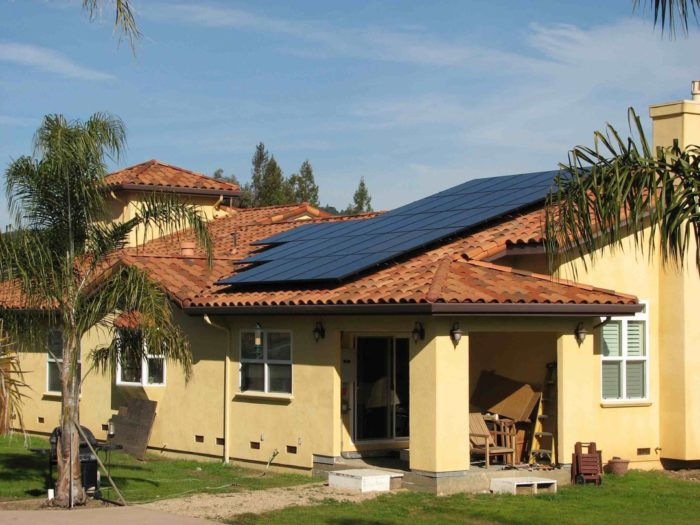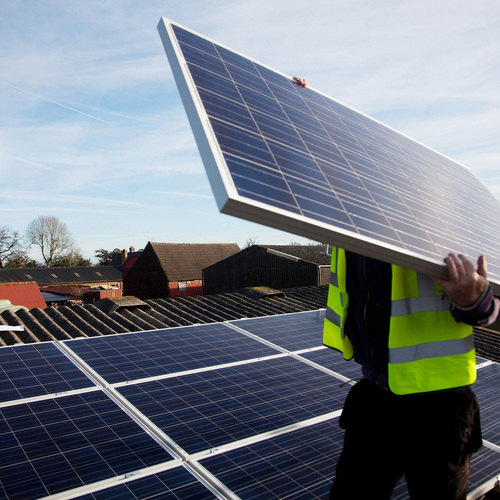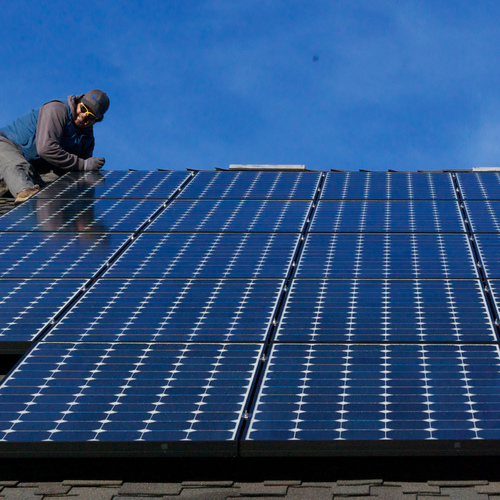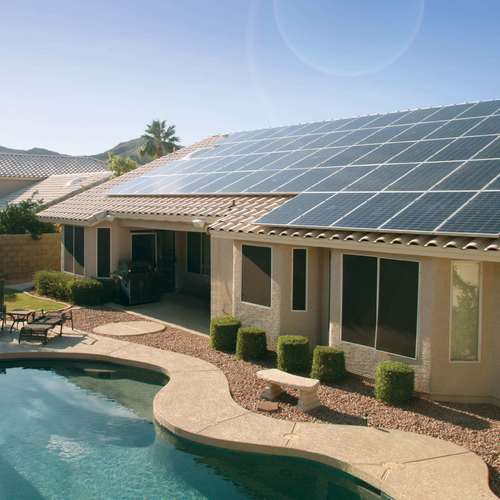
The number of new rooftop photovoltaic (PV) installations in the area covered by the Arizona Public Service Company is dropping, and the vice president of a California company that finances solar leases says a new monthly fee for photovoltaic systems is the culprit.
According to a report in The Republic, the number of rooftop installations fell from 583 in January of last year to 280 last month.
Bryan Miller, vice president for public policy and power markets for Sunrun, blamed the drop on the fee that was adopted last November and went into effect at the start of the year.
“You have an industry that is in grave pain in Arizona,” he told The Republic. “It is in stark contrast with what is going on in the rest of the solar industry.”
Arizona Public Service, like several other electric utilities around the country, have voiced concerns that the growing number of residential photovoltaic installations is unfairly shifting the cost of maintaining the grid to non-solar customers. Its arguments last year before state regulators that customers with PV systems weren’t paying their fair share led to the new fee.
According to the website Utility Dive, state regulators agreed to impose the fee of 70 cents per kilowatt, or roughly $5 per month for an average installation, on customers who install PV systems beginning this year. But it did not affect the 20,000 customers who already had them.
The fee voted in by the Arizona Corporation Commission was the first of its kind in the U.S., but the utility said it “fell well short” of what it needed, Utility Dive reported.
Net-metering rules, by which utility customers sell excess power produced by their PV systems, were left unchanged. According to information posted at DSIRE, an online data base, owners of PV systems get paid the retail rate for excess electricity.
Utility and regulators discuss renewable requirements
In Arizona, a complicating issue is how Arizona Public Service will meet state requirements that a certain percentage of its electricity come from renewable sources. For this year, that’s set at 4.5%, 1.4 % of which must come from rooftop solar or other “distributed” sources, The Republic reported. The renewable requirement rises to 15% by 2025.
The utility has enough solar customers now to meet requirements through 2016.
The rub is a requirement in the 2006 law requiring Arizona Public Service to get renewable-energy credits (RECs) from rooftop solar in order to comply. The utility initially paid rebates to customers who installed solar and in the process acquired the RECs for their solar panels. But rebates are no longer offered, and as a result Arizona Public Service no longer gets the RECs.
The utility and state regulators are currently discussing how the requirement will be met in the future.
Spain struggles with the same issue
The debate over net-metering and the impact of residential PV installations isn’t limited to the U.S. In Spain, the government is cutting compensation for solar installations. Large photovoltaic plants will see the biggest reductions, up to 45% of current payments, according to the website Solar Server.
A group called the National Association of Photovoltaic Energy Producers says the new policy will affect 55,000 Spanish families who invested in solar and could force some of them into bankruptcy because they borrowed heavily to make the installations.
One of them, whose story appeared in The New York Times last month, mortgaged his house, his father’s house, and his workshop in order to install a PV system. He based the investment on government promises of generous rates for the energy he produced.
The government about-face will cost the Spanish investor everything he has.
Spain is proposing other measures, including a fee on electricity that solar producers generate and use themselves, which opponents call the “sun tax.”
Weekly Newsletter
Get building science and energy efficiency advice, plus special offers, in your inbox.















6 Comments
ALEC is at it again
It may have started in Arizona, but ALEC (the conservative lobbying organization composed of Republican legislators and corporations) plans to make it happen in every state that has a net metering policy.
http://www.huffingtonpost.com/gabe-elsner/the-campaign-against-net-_b_4297678.html
APS buy-back rates are very low...plus more charges
Although DESIRE says that the PV installation electricity rate for buy backs is at retail, that information is obsolete. Along with the APS efforts to discourage rooftop solar with the new fee (they wanted monthly fees of $100 or more!), they also actively discourage "excess" power generation capacity and pay for power feed-in at a small fraction of the rate for retail power. The rate varies a bit with time and installation, but the "buy" rates are all around $0.03/kWh, while base retail rates start at $0.06 for winter off-peak, rising to $0.47 for summer super-peak. In addition, they've added a "lost fixed charge recovery rate" to their time-of-use "discount" plans to "recover" the supposed additional income lost to pay for infrastructure, as well as nearly double (vs. standard rate schedule) fixed-charge base fees. The result is that merely being a "green" conscientious user who is connected, with no net power use, results in charges of about $35/mo with tax! These fees also ensure that most of the savings of the time-based plans disappear vs. standard rates. Finally, I should note that the only two commissioners voting against the new fee were not opposed to it...they want it to be much higher!
$5/month scuttles the deal?
If I wanted solar in AZ, I'm not sure a $5/month fee would scare me away. There must be more to it than that.
Response to Eric Sandeen
Eric,
In Phoenix, Arizona, a 1-kW system produces $137 worth of electricity a year. So, to produce $60 of electricity a year, you have to install a 438-watt system. All of the production from that PV system (one that costs about $1,750 to install) goes straight to the utility as a kind of tax. That's a drag.
Response to Martin Holladay
I think you're off by a factor of 7. :)
The quoted "tax" was 70 cents per (1) kW; $5 was for a "average" system, which must be around 7kW.
So for your 1-kW system, you only need to produce (12 x $0.70) = $8.40/year to cover it, or about 60 watts of your system dedicated to that purpose. At $4/watt that's $240 up front for that extra fee-covering 60W.
No doubt it's a drag, it just doesn't seem like that big of a drag. Odds are shading issues would cause more "loss." (Don't get me wrong, I think the utilities pushing back in this way is wrong-headed, but I can't imagine that $5/month fee on a 7kW array is the kind of dealbreaker that causes installations to fall by 50%).
Response to Eric Sandeen
Eric,
Thanks for your corrected math.
However, it's still worth pointing out that if you want a 7-kW system, the first $1,750 you invest in PV modules goes for equipment that will be forever generating electricity that you won't see -- all of the electricity produced by those PV modules goes to the utility, and you won't see a penny from those modules' production. Just saying.
Log in or create an account to post a comment.
Sign up Log in